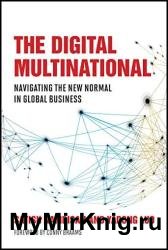 Название: The Digital Multinational: Navigating the New Normal in Global Business Название: The Digital Multinational: Navigating the New Normal in Global Business
Автор: Satish Nambisan, Yadong Luo
Издательство: MIT Press
Серия: Management on the Cutting Edge
Год: 2022
Страниц: 261
Язык: английский
Формат: pdf (true), epub (true)
Размер: 10.2 MB
How multinational companies can use digital technology to compete in a world where business is driven by the forces of both globalization and deglobalization.
Digital technology has put globalization on steroids; multinational companies now account for one-third of world GDP and one-fourth of world employment. And yet complicating this story of unchecked global capitalism are two contradictory forces. Even as advances in digital technology enable borderless markets, a new nationalism has emerged, reviving protectionism and railing against digital colonialism. In The Digital Multinational, management experts Satish Nambisan and Yadong Luo examine how companies can adopt a dual strategy to cope with this new normal: harnessing the power of digital technology while adapting to the geopolitical realities of particular markets.
Key to success, Nambisan and Luo explain, is the notion of tight and loose coupling to characterize the relationship of the digital multinational to its global partners and subsidiaries. Identifying the tightness-looseness requirements of global business connectivity leads to successful business strategy. Drawing on real-world examples that include Burberry’s entrance into the Chinese market, Unilever’s AI-powered global talent marketplace, and the Vocal for Local movement in India, they develop a typology of global business contexts; discuss digital strategies for entering new markets, establishing digital platforms, managing globally dispersed activities, and pursuing innovation; and explain how these strategies can be part of a business leader’s toolkit. The Digital Multinational is an essential guide to competing in a business world driven by both globalization and deglobalization.
What is driving this new rapid upward trajectory in globalization? The short answer is digitization. Advances in digital technologies - from the internet and mobile computing to Artificial Intelligence (AI), the Internet of Things (IoT), virtual reality (VR), and blockchain - have forged new pathways to bind different parts of the world, new information pathways, thereby inaugurating a new era in globalization, digital globalization.
Digitization has allowed companies to create, deliver, and appropriate value in novel ways that are largely agnostic to national and geographical borders. Indeed, digital globalization connects international businesses and markets through flows of data, expertise, and intellectual assets and through flows of goods, services, and capital that are digitally enabled or supported. Digital technologies have also allowed more diverse sets of actors to participate in cross-border transactions than ever before, from new ventures and small businesses to multinational enterprises, enhancing the scope and reach of globalization. And the faster-than-normal speed in global expansion is not limited to “digital natives” such as Airbnb, OYO, Uber, and Ola. Companies that deal with physical goods and services are also enjoying accelerated international expansion due to digitization.
Contents:
Series Foreword
Foreword
1 Globalization in Transition in the Digital Age
2 Digital Global Business Connectivity
3 Connecting with Global Markets and Customers Digitally
4 Connecting with Global Partners, Platforms, and Ecosystems Digitally
5 Connecting with Foreign Subsidiaries and Managing Global Activities Digitally
6 Connecting with Global Innovation and Knowledge Digitally
7 Internationalizing Business Models Digitally
8 Global Entrepreneurship in the Digital Age
9 Managing Risks in Digital Global Business
10 Digital Intelligence and Digital Resilience: Putting Digital Global Business Connectivity into Practice
Acknowledgments
Notes
Index
Скачать The Digital Multinational: Navigating the New Normal in Global Business
|